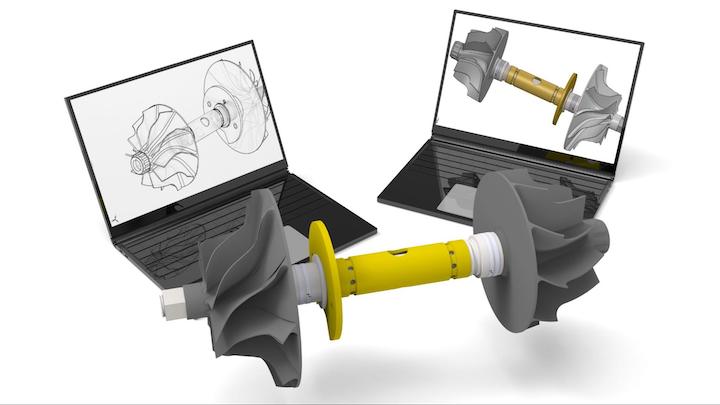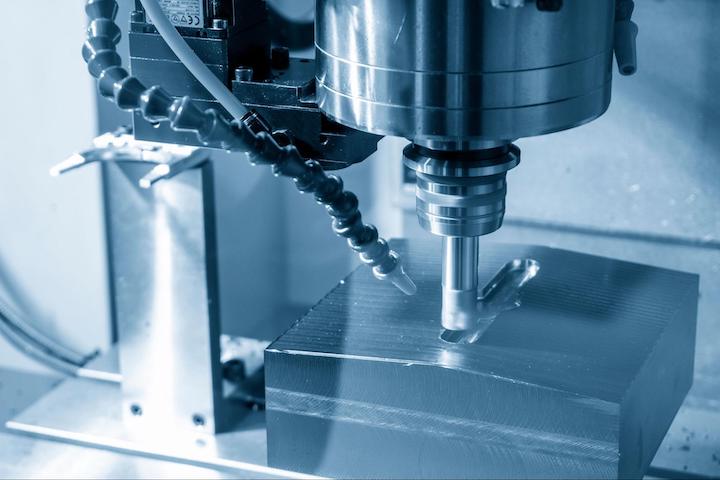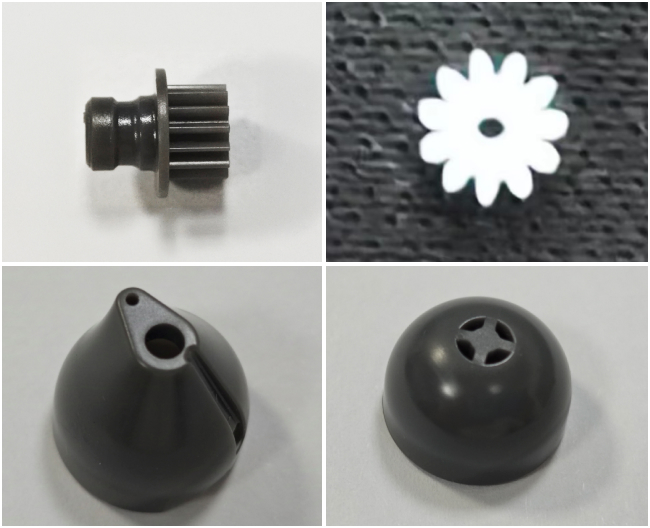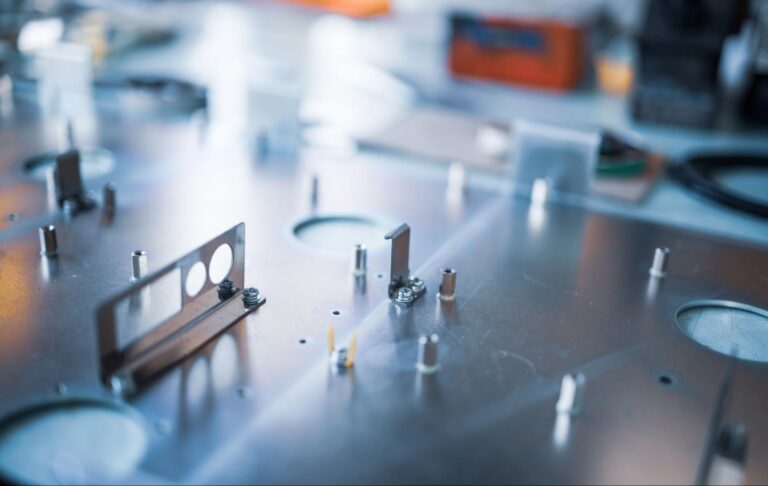Time to read: 6 min
Creo and SolidWorks® are considered powerful CAD packages that can generate 3D models, shop drawings, and G-code for CNC machining. Both programs can simulate designs to ensure they can handle the applied loads. Each is available in various tiers of functionality and price with different features. SolidWorks® has more flexible licensing options when compared to Creo, but the baseline Creo package is more powerful than the baseline SolidWorks package. This article explores the differences between these two software products, what features they offer, their useability, system requirements, and applications.

What Is Creo?
Creo is a parametric CAD system that used to be called pro-engineer or ProE. As a refresher, a parametric CAD system allows a user to adjust the dimensions and features that define the model without having to redraw the model every time. Creo is considered a top-range CAD program due to its extensive list of features and tools.
Higher-tier Creo packages come with MathCAD®, an alternative to using Excel to document engineering calculations. MathCAD® lets engineers use normal mathematical notation to set up equations and keep track of units. CAM (computer-aided manufacturing) features are only available in the two top-tier packages. Regardless of the package, Creo is a powerful engineering tool with useful and powerful features.
What Is SolidWorks?
SolidWorks is also a parametric CAD software that was developed by Dassault Systemes®. SolidWorks is considered a mid-range CAD program, yet is widely used in the design and fabrication industry. SolidWorks has CAE (computer-aided engineering) and CAM (computer-aided manufacturing) functionality and powerful CAD capabilities. SolidWorks can be used to create 3D models and corresponding shop drawings. Some licenses even have access to MBD (model-based definition) features that help eliminate the need for shop drawings altogether.
Creo vs. SolidWorks: Pricing Plans
Software, in general, has moved to a subscription model, and SolidWorks and Creo are no exceptions. However, SolidWorks can be purchased as a perpetual license, though this license is only for a specific version of SolidWorks. Listed below are more pricing details for these two software packages:
Creo
Creo can be purchased as a yearly subscription, and five different packages are available:
- Design Essentials
- Design Advanced
- Design Advanced Professional
- Design Premium
- Design Premium Professional
Even the most basic version of Creo, Design Essentials, is a capable CAD package that comes with features that must be purchased separately from other CAD software, like SolidWorks. Beyond Design Essentials, other versions of Creo have mold design, CAE (computer-aided engineering), and CAM (computer-aided manufacturing) featuresets.
Design Essentials starts at $2,780 for a single locked license, and Creo also offers floating licenses. To get accurate pricing for the more capable versions, contact Creo directly for a quote or, alternatively by contacting a local reseller.
SolidWorks
A SolidWorks license can be purchased in a number of different ways — a perpetual license with the option for an annual subscription service, a term license, or a subscription license. SolidWorks has three main packages:
- SolidWorks Standard
- SolidWorks Professional
- SolidWorks Premium
These versions can be further modified with additional packages at an additional cost, such as SolidWorks Visualize and SolidWorks CAM, that add functionality to the base software. The basic SolidWorks license comes with rudimentary CAE (computer-aided engineering) capabilities, but SolidWorks Premium has fully fledged CAE capabilities.

Creo vs. SolidWorks: Support
SolidWorks and Creo are professional software packages, and as such, both provide excellent support in the form of in-software tutorials, help files, community and official support forums, YouTube channels, direct access to support staff, and access to certified courses. In my experience, both companies provide great technical support, and the customer service I personally received from SolidWorks has been outstanding!
Creo vs. SolidWorks: File Formats
SolidWorks and Creocan both process standard neutral CAD formats. Creo has a Multi-CAD feature that imports native file formats from some common professional CAD systems, and SolidWorks has a similar feature called 3D Interconnect. This makes it easier for engineers who need to use CAD models from many different suppliers when designing a complex assembly — however, a SolidWorks professional license is needed to import Catia files. Below, you can see a list of common file formats for each CAD system:
| Creo | SolidWorks | |
| Neutral CAD Formats | .stp, .igs, .stl, .x_t, .obj | |
| Proprietary Formats | Inventor (.ipt, .iam) | Inventor (.ipt, .iam) |
| SolidWorks (.sldprt, .sldasm) | Creo (.prt, .asm) | |
| NX (.prt) | NX (.prt) | |
| Solid Edge® (.par, .asm, .psm) | Solid Edge® (.par, .asm, .psm) | |
| Catia (.CATPart, . CATProduct) | Catia (.CATPart, . CATProduct) | |
| Native Formats | Part File: .prt | Part File: .sldprt |
| Assembly File: .asm | Assembly File: .sldasm | |
| Drawing File: .drw | Drawing File: .slddrw | |
Table 1: Creo vs. SolidWorks File Formats
Creo vs. SolidWorks: Learning Curve & Usability
SolidWorks and Creo are professional tools engineers and draughtspersons use to design complex products and are designed to be usable for their target market. SolidWorks is considered easier to use, especially for beginners, whereas Creo is considered to be more advanced software. It’s easier to get started with SolidWorks than it is with Creo because SolidWorks is designed to be as user-friendly as possible. Creo, on the other hand, is traditionally more difficult to learn.
That said, Creo functions have been made more accessible to beginners in recent years. For a professional CAD user, moving between these software platforms is relatively easy, since they both operate parametrically. Learning how to perform certain functions in each application may take some time, but both Creo and SolidWorks have built-in tutorials on how to use the software.

Creo vs. SolidWorks: System Requirements
Creo was originally developed with performance in mind, so it can handle larger assemblies smoothly. SolidWorks, however, will begin to slow down as models get larger and more complex, though it has features such as large assembly settings and virtual components that help reduce the load of large assemblies on a system. Despite these features, Creo is still much more capable of handling large, complex assemblies. These are the system requirements for each program:
| Creo | SolidWorks | |
| Operating system | Windows 10, Windows 11 | Windows 10, Windows 11 |
| CPU | Dual-core or greater, 2-GHz x86, 64 bit | 64 Bit Intel or AMD |
| Disk space | 5 GB for installation, SSD recommended | |
| GPU | 3D-capable graphics card, dedicated CAD graphics card recommended | |
| Ram | 4 to 16 GB | 8 to 16 GB |
Table 2: Creo vs. SolidWorks System Requirements
Creo vs. SolidWorks: Applications
SolidWorks and Creo are both used to design complex mechanical equipment, but Creo has an excellent surfacing toolset that is far better than the SolidWorks offering. Creo is better suited to designing products with complex curves, such as single-use plastics, enclosures for consumer products, and the injection molding tooling used for these applications.
SolidWorks and Creo both have powerful FEA (finite element analysis) functionality that can simulate how a part behaves under loading. Creo is widely used in the automotive industry, where large, complex assemblies are the norm, while SolidWorks is better suited to designing industrial mechanical equipment.
Which Software to Use?
Deciding which CAD package to use is challenging because once you make your choice, you are essentially locked into the ecosystem and cannot easily change. However, if you’re making use of large, complex assemblies that incorporate complex surfacing, Creo is a better choice. SolidWorks is easier to learn and is better used for medium-sized mechanical projects like industrial gearboxes or other mechanical equipment. Here’s the breakdown:
Advantages of Creo
Creo is ultimately a more fully featured CAD package when compared to SolidWorks, which provides these additional advantages:
- Lightweight: Creo was designed from the ground up to be lightweight. As such, Creo can run complex assemblies with thousands of parts without slowing down as much as SolidWorks.
- Powerful Surface Modeling: Creo has robust features for producing parts using surfacing tools and techniques.
Advantages of SolidWorks
SolidWorks is a beginner-friendly CAD package with more than enough features for most small to medium-engineering projects. Listed below are some additional advantages:
Easy to Learn: SolidWorks is easier to learn when compared to Creo. Despite Creo’s efforts to make their software more user-friendly, SolidWorks still takes the lead.
Large Online Community: SolidWorks has a larger online community presence when compared to Creo. This means there are more online tutorials and support.
Fictiv — Your Custom Manufacturing Partner
Fictiv is your operating system for custom manufacturing, whether you’re injection molding, CNC machining, 3D printing, or urethane casting — our global network of manufacturing partners has some of the most skilled operators in the world.
Plus, our design for manufacturing (DFM) feedback will help refine your CAD models to ensure success — no matter how complex your designs are, and whether you made them using Creo, Solidworks or another program altogether!
To get started, create your Fictiv account and request a free, instant quote today.










